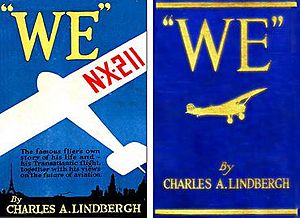"WE" (1927 book) facts for kids

Dustjacket and cover (1927 first edition)
|
|
| Author | Charles A. Lindbergh Fitzhugh Green (appendix) |
|---|---|
| Country | United States |
| Language | English |
| Genre | Autobiography |
| Publisher | G. P. Putnam's Sons |
|
Publication date
|
July 27, 1927 |
| Pages | 318 |
"WE" is a book written by the famous pilot Charles A. Lindbergh (1902-1974). It tells the story of his life, especially leading up to his amazing solo flight across the Atlantic Ocean in May 1927. Lindbergh flew from New York to Paris in his special airplane, the Spirit of St. Louis. This book was first published on July 27, 1927, by G.P. Putnam's Sons in New York.
Contents
Creating the Book: "WE"
Just 57 days after his historic flight, Charles Lindbergh's book "WE" was released. He was only 25 years old when he made the first non-stop solo flight across the Atlantic. He flew from New York to Paris on May 20–21, 1927, in his single-engine plane, the Spirit of St. Louis.
The book was published by G.P. Putnam's Sons, a New York company run by George P. Putnam. Lindbergh wanted to write the book himself. He wanted to share his "own story of his life and his transatlantic flight together with his views on the future of aviation".
What Does "WE" Mean?
The book's title, "WE", was chosen by the publisher. They said it meant a "spiritual" partnership between Lindbergh and his airplane. However, Lindbergh later said this was not correct. He explained that "we" actually referred to himself and the people in St. Louis who helped pay for his flight. Even so, he often used "we" when talking about himself and the Spirit of St. Louis.
Writing the Story Quickly
After his flight, Lindbergh was very busy with celebrations. A reporter quickly wrote a first draft of the book for him. But Lindbergh, who was very careful, did not like it. He felt it had mistakes and didn't sound like him.
So, Lindbergh decided to rewrite the entire book himself. He did this in less than three weeks! He worked alone at the home of Harry Frank Guggenheim, a businessman and aviation supporter. Lindbergh wrote "painstakingly in longhand," meaning he wrote every word by hand.
The New York Times newspaper noted how careful Lindbergh was. They said he refused to rush the book. He wanted it to be the most accurate story of his life and flight.
Book's Success and Impact
"WE" was published on July 27, 1927. Within six weeks, it sold over 190,000 copies. A special limited edition of 1,000 signed copies also sold out very quickly. The book was soon translated into many languages around the world. It stayed on the best-seller lists for a long time.
The book's success was helped by Lindbergh's tour across the United States in the Spirit of St. Louis. He traveled 22,350 miles, visiting 82 cities in all 48 states. During this tour, he gave 147 speeches and rode in many parades. More than 30 million Americans saw him in person! This tour helped make "WE" one of the most successful books of its time.
Thoughts from Others
Myron T. Herrick, the U.S. Ambassador to France, wrote a foreword for "WE". He said that flying was Lindbergh's passion. He believed the book would help people learn more about aviation.
The book also includes an essay by editor Fitzhugh Green. This part describes how the world welcomed Lindbergh after his flight. It talks about the celebrations in Paris, Brussels, London, Washington, New York, and St. Louis.
Interestingly, only a small part of "WE" (18 pages) is about the flight itself. Most of the book focuses on Lindbergh's life before May 20, 1927. Lindbergh would later write another book, The Spirit of St. Louis, in 1953, which gave a full account of his famous flight.
Lindbergh's Training
In "WE", Lindbergh wrote about how important his U.S. Army flight training was. He said this training (from 1924–1925) helped him become a focused and skilled pilot. This skill was key to his amazing transatlantic flight just two years later.
He noted: "Always there was some new experience, always something interesting going on to make the time spent at Brooks and Kelly one of the banner years in a pilot's life." Lindbergh believed the training was tough but excellent. He said that cadets had to focus completely on flying. When they finished, they knew they had graduated from one of the best flying schools in the world. ("WE", page 125)

